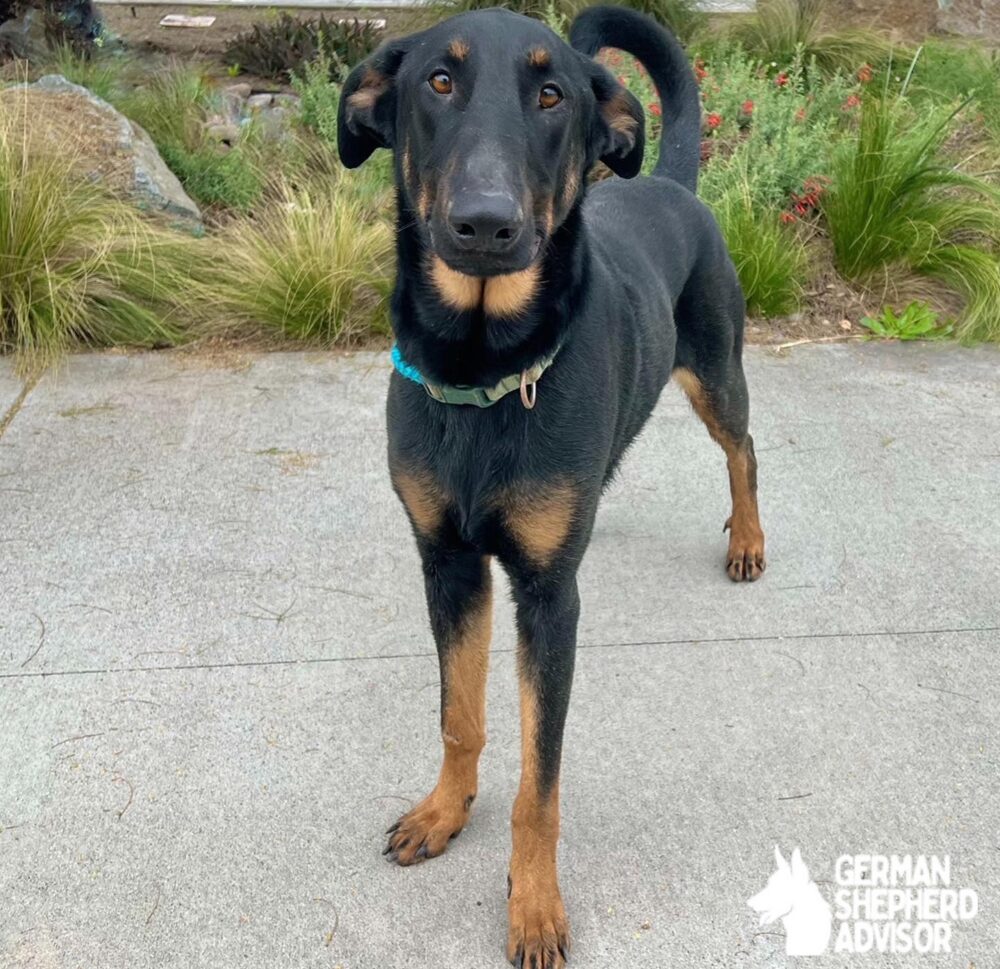The Doberman Shepherd is a working class hybrid breed creation of the ever loyal German Shepherd and the always Protective Doberman Pinscher, combining power and brains into one breed. In this article, we take a look at the important traits of the German Shepherd Doberman mix, how to care for one and some commonly asked questions so you know if this astounding dog is the right match for you and your family.
German Shepherd Doberman mix – At a glance
| Weight: | 70–110 pounds |
| Height: | Males 24–28 inches, while females 22–26 inches. |
| Lifespan: | 10–14 years |
| Coat colours: | Any combination of black, tan and brown; usually all three. |
| Temperament: | Intelligent, loyal, protective, alert, vigilant, and highly loyal to its family, loving and playful with its family members. |
| Suitable for: | Experienced dog owners, Active families with children, individuals. |
| Exercise: | 1–2 hours of exercise daily. |
| Grooming: | Relatively low |
| Cost: | $200–$500 from a reputable breeder. |
What does a German Shepherd Doberman mix look like?
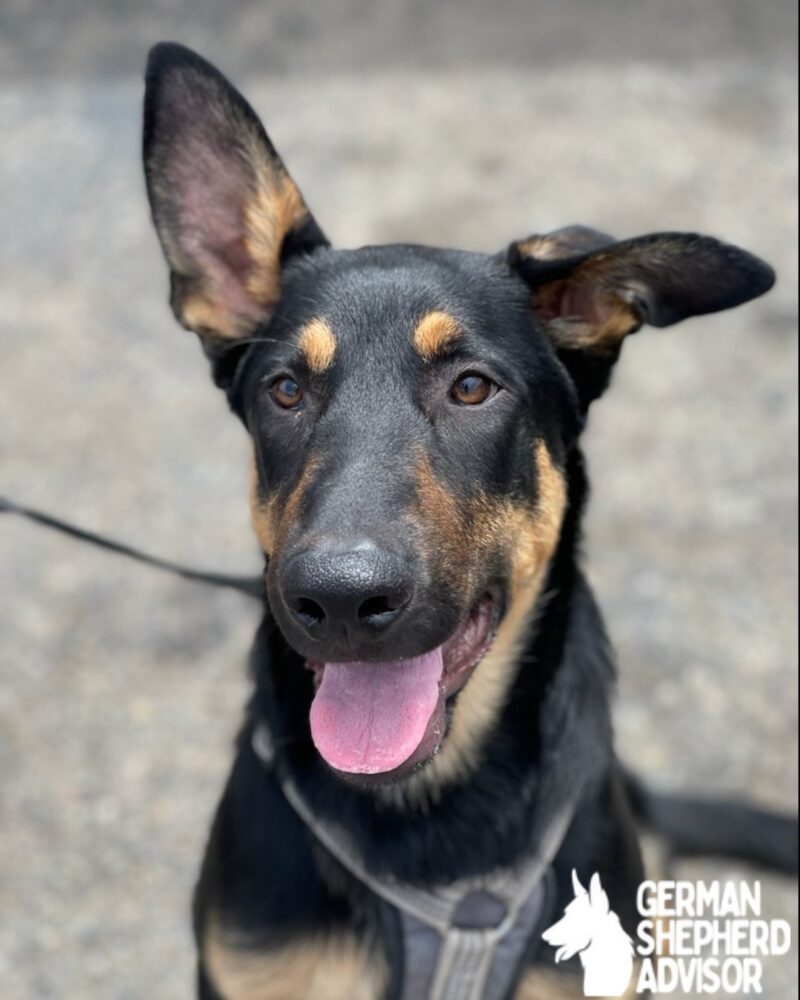
They generally have an athletic figure with a defined, muscular build. Often this hybrid has the Doberman’s smooth coat, although he may also carry some of the German Shepherd double coat fluff. Depending on their parent’s genetic dominance, they may have erect or floppy ears but typically feature a coat color of any combination of black, tan and brown; usually all three.
They are 24 to 28 inches tall for males, and about 22 to 26 inch tall for females. In This breed typically weighs 70-100 pounds. Depending on the type of undercoat the German Shepherd Doberman mix inherits, it will have short to medium-length coat with low to moderate shedding.
What is the temperament of German Shepherd Doberman mix?
The German shepherd and Doberman have a solid reputation for intelligence, loyalty, and protective instincts. Consequently, the dog has the curious and protective nature of a working breed, always aware in its surroundings, loyal as ever to his family. This breed tends naturally towards being protective, and may be reserved around strangers while known for affection and playfulness with those in its family group.
The Doberman Shepherd is very alert which makes him a great watchdog. The Doberman Shepherd is highly intelligent and very trainable, as they can quickly learn many commands and complicated tricks. A highly energetic blend, this is suited for active families or individuals who partake in outdoor activities.
How long does a German Shepherd Doberman mix live?
The average lifespan of a German Shepherd Doberman mix is around 10–14 years.
What health conditions could the German Shepherd Doberman mix have?
The German Shepherd Doberman mix can inherit health issues common to both parent breeds.
Some of the main health concerns for this mix include:
Hip Dysplasia
Hip dysplasia is a widespread disorder for large breeds, characterised by the incorrect fitting of the hip joint in its socket which, as time goes on, will cause pain and arthritis and problems with mobility. Most important is regular exercise and a healthy weight — reduce the risk; but glucosamine may help.
Elbow Dysplasia
Much like hip dysplasia, this condition affects the elbow joint and is painful while also leading to arthritis. Exercise and weight control are essentials to lessen the effects of this.
Dilated Cardiomyopathy (DCM)
Doberman is genetically prone to DCM (Dilated cardiomyopathy), which lowers the muscle of the heart, making it thin and weak; this leads to difficulty pumping blood. It is advised to undergo regular heart checkups in order to identify Initial symptoms.
Bloat (Gastric Dilatation-Volvulus)
Also called gastric dilatation volvulus, this is a serious condition causing the stomach to twist shut, trapping gases and food inside. Risk factors include large deep-chested breeds This can be avoided by feeding smaller, frequent meals and not exercise straight after a meal.
Degenerative Myelopathy
Degenerative myelopathy is a progressive spinal cord disorder that causes weakness and paralysis of the hind limbs, most often seen in German Shepherds. Although it is not curable, physical therapy and supportive care will provide patients with a better quality of life.
Von Willebrand’s Disease
This is a clotting disorder that is common in Dobermans, and can result in bleeding profusely from small injuries. Although there is no cure, it can be managed with medication and your veterinarian needs to know before any surgical procedures.
Hypothyroidism
Hypothyroidism, another common endocrine disorder in both parent breeds, results in a slower metabolism and consequent weight gain, lethargy and skin disease. Medications assist in balancing thyroid hormone levels.
Progressive Retinal Atrophy (PRA)
PRA is an inherited eye disease that can progress to vision loss and ultimately blindness for dogs. This is why it important to have regular eye exam, so we can keep an eye on it.
Skin Allergies
Skin Allergies: Doberman Shepherds are susceptible to skin allergies, which may be triggered by environmental factors, food allergies, or genetic predisposition. Hypoallergenic diets and medicated shampoos usually do the trick for skin allergies.
Preventative Measures and Regular Care
Routine Veterinary Checkups: Early detection is key in managing health conditions. Regular visits can help catch issues like hypothyroidism, early signs of heart disease, or joint problems before they progress.
Balanced Diet and Exercise: A high-quality diet supports overall health, while consistent exercise helps maintain a healthy weight, which is particularly important for joint health.
Responsible Breeding Practices: Ensuring breeders screen for genetic health issues like hip dysplasia and Von Willebrand’s disease can reduce the likelihood of inheriting serious conditions.
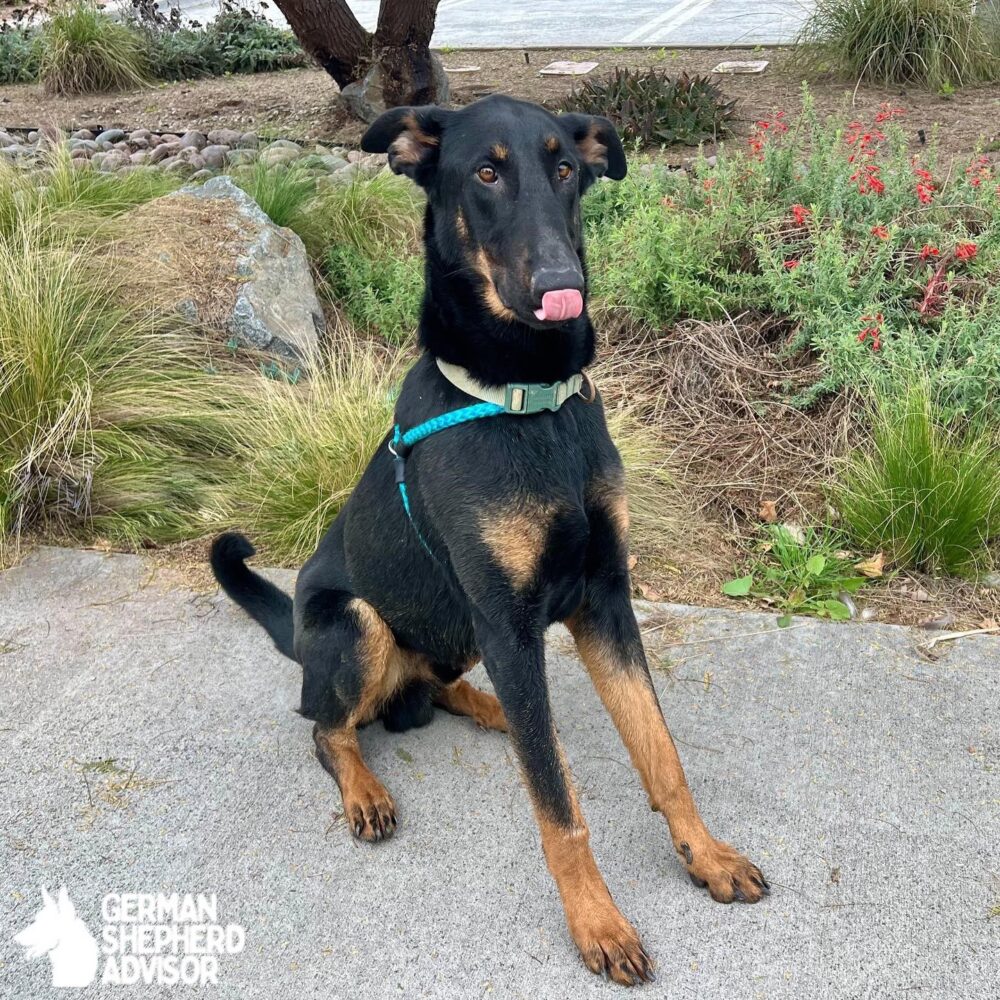
How much exercise does a German Shepherd Doberman mix need?
To be precise, Doberman Shepherds require at least 1-2 hour of exercise each day. It is best when aerobic, muscle-building exercises, and play are all part of the exercise routine. A regular dose is the key — and that means long daily walks or runs. At least an hour of walking, brisk walk or jogging per day — can break into two sessions if preferred.
This breed loves to accompany you when running, so is also enthusiastic in your bicycle or jogging tour. They get some time off-leash in a secure, fenced yard where they can run and explore. Fetch is also a good option, and socialization with other dogs in a dog park running can work too.
Agility training is a fantastic form of exercise and mental stimulation for Doberman Shepherds since they are agile, quick learners. Think about agility courses with jumps, tunnels and weave poles to develop their strength and coordination.
Swimming is a great low-impact exercise for the joint health of many Doberman Shepherds. In that way, they are able to cool off their bodies while also burning energy. If you enjoy heading off into the wilderness and will be doing a lot of walking, Doberman Shepherds make excellent hiking buddies due to their endurance. Varied terrain will also engage them mentally as well encountering various new smells and sights.
Mental Stimulation: German Shepherd Doberman mix
Besides exercise, Doberman Shepherds need mental exercises regularly as well to stay stimulated and satisfied. They might develop unwanted behaviors such as barking too much or chewing things if they lack this stimulation.
Obedience Training
Obedience training provides mental stimulation and reinforces good behavior, both areas that Doberman Shepherds excel in. Repeat commands and later, try more difficult ones or some tricks so your pup never gets bored.
Puzzle Toys
You can hide treats in puzzle toys to get them working on their problem-solving skills. Consider toys that require your dog to work for a treat (they are not all done with ease), because they will provide mental stimulation by utilizing the natural intelligence of your pup.
Interactive Games
Fun games such as hide-and-seek (hiding treats or toys for your cat to find) offer a mental workout. Olfactory games can be particularly appealing to them, prompting them to use their instinctive tracking skills.
Canine Sports
They do well in canine sports like rally obedience, Schutzhund (to prove dogs as working animals using the three important skills of tracking, obedience and protection), and nose work. Stimulating and great for their bodies these sports provide a lot of structure for children.
Experiencing New Environments and Socialization
Mental stimulation comes from regular exposure to various environments, sounds and people. Visit dog-friendly places, the dog park, or attend pet-friendly events so they do not become too protective or shy.
Advanced Training
This breed loves dog training, but it enjoys advanced training—learning to recognize objects by their names or perform complicated tasks. They live to learn and relish in the learning process of new skills.
Tips for Balancing Physical and Mental Stimulation
Combine Activities: Integrate mental and physical stimulation by doing activities like agility training or obedience training during walks.
Vary Routine: Change their exercise and training routine regularly to keep things interesting. Rotate between games, activities, and routes to prevent boredom.
Consistency: Make exercise and mental activities part of a daily routine, as this breed thrives with structure.
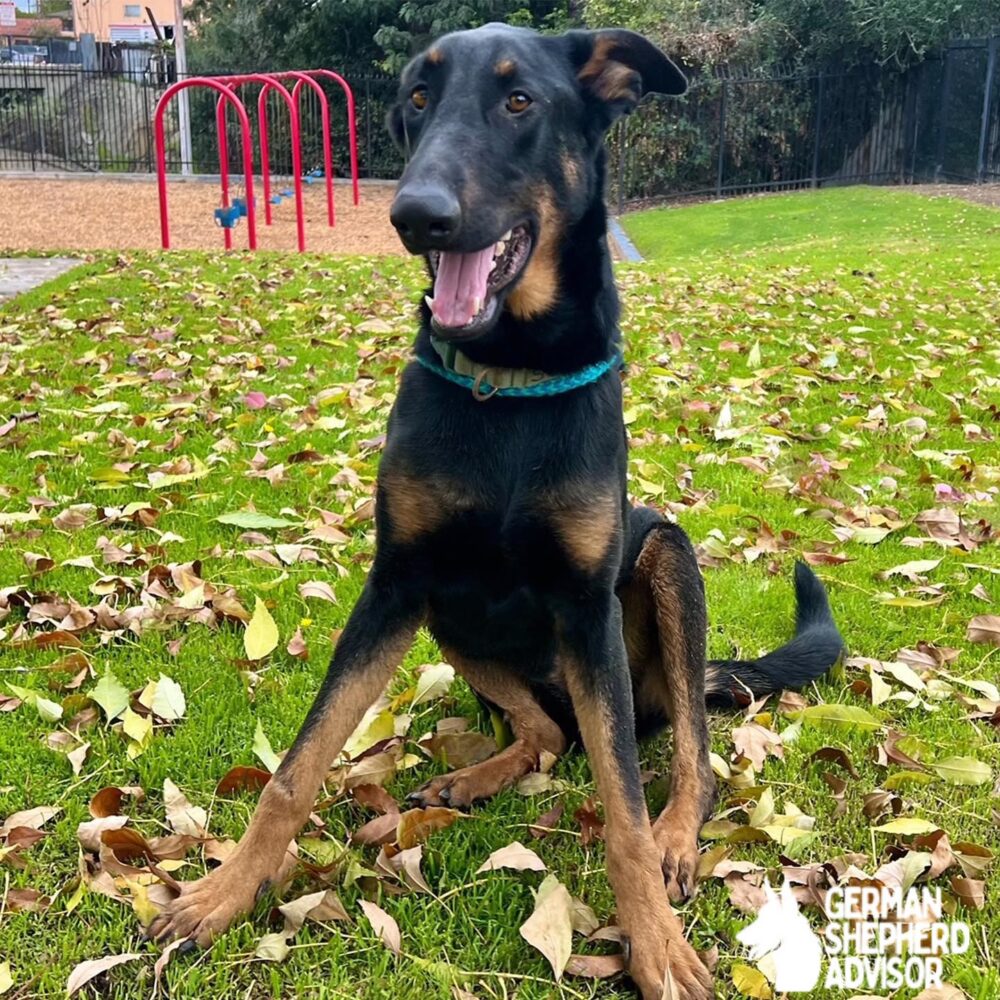
Is German Shepherd Doberman mix easy to train?
Although the Doberman Shepherd is intelligent and responds well to training, this breed requires a firm yet gentle hand. That is why early socialization makes sure they grow to be or manner well behavior adults. This breed best responds to positive reinforcement techniques, so treats, praise and frequent training sessions work well.
The German Shepherd Doberman mix literally German shepherds a high-energy dog, intelligent and full, who outright needs both physical exercise as well as mental stimulation to stay sound and happy. Because they are both extremely active and intelligent, a daily schedule full of activities is critical to bypass boredom—which can cause behavioural problems.
Is German Shepherd Doberman mix good with children and other pets?
The Doberman Shepherd, a mix of German Shepherd and Doberman has the potential to be good with children and other pets if socialization, training and temperament are right.
Below is how this breed typically may behave around kids and pets:
Interaction with Children
While both breeds are known to be protective (and in fact, the Doberman was originally created during the late 1800s for protection purposes), they also tend to inherit this trait from their German Shepherd and Doberman parents. It means they are going to be protective with kids inside the house, leading to a great loyalty and bond. But their instincts to protect may also lend a wariness around unknown kids.
The Doberman Shepherd is very playful and energetic which is ideal for older kids since they can keep up with their energy levels. Due to their high amount of energy they will keep your active kids busy, playing for example Fetch or running.
They are large, strong animals and supervision is necessary around younger or smaller kids. Because Doberman Shepherds do love to play, it is imperative to bring a sense of control, and maintain rules and politeness around children by showing them how not to accidentally bow over smaller kids.
If you socialize Doberman Shepherds from an early age they can be very gentle and patient around children. You are teaching them commands like “sit,” “stay” and “gentle” that can help you survive their children in less time.
Interaction with Other Pets
For Doberman Shepherds, they tend to do okay with other dogs too but especially if raised together. From puppy-age it is best to have them mingle with other kinds of dogs so they can learn how to act around others and will often not be territorial or aggressive.
As Doberman is a working breed, Doberman Shepherds may have a stronger instinct to chase and therefore you should consider their prey drive when near smaller animals (cats, rabbits or other small pets). They need supervision and training if they are around small animals.
German Shepherds and Dobermans also have the property protection drive that can easily be inherited to the Doberman Shepherd. They learn to share space in a controlled environment and are done so they minimize the risk of possessiveness.
The key is early proper socialization with various other animals. Gradual gentle exposure to the pets around in a controlled calm environment which means allowing the Doberman Shepherd to get used to their presence Teaching them to obey commands like “leave it” can also teach them boundaries with other animals.
Grooming Requirements: German Shepherd Doberman mix
The grooming needs of the Doberman Shepherd are relatively low. Weekly brushing will usually suffice, although more frequent brushing is needed during shedding seasons if they have a German Shepherd-like coat.
Brushing: Once or twice a week.
Bathing: Only as needed to avoid stripping natural oils.
Nail Trimming: Monthly, or as needed if nails do not wear down naturally.
Pros and Cons of Owning a German Shepherd Doberman mix
How much does a German Shepherd Doberman mix can get?
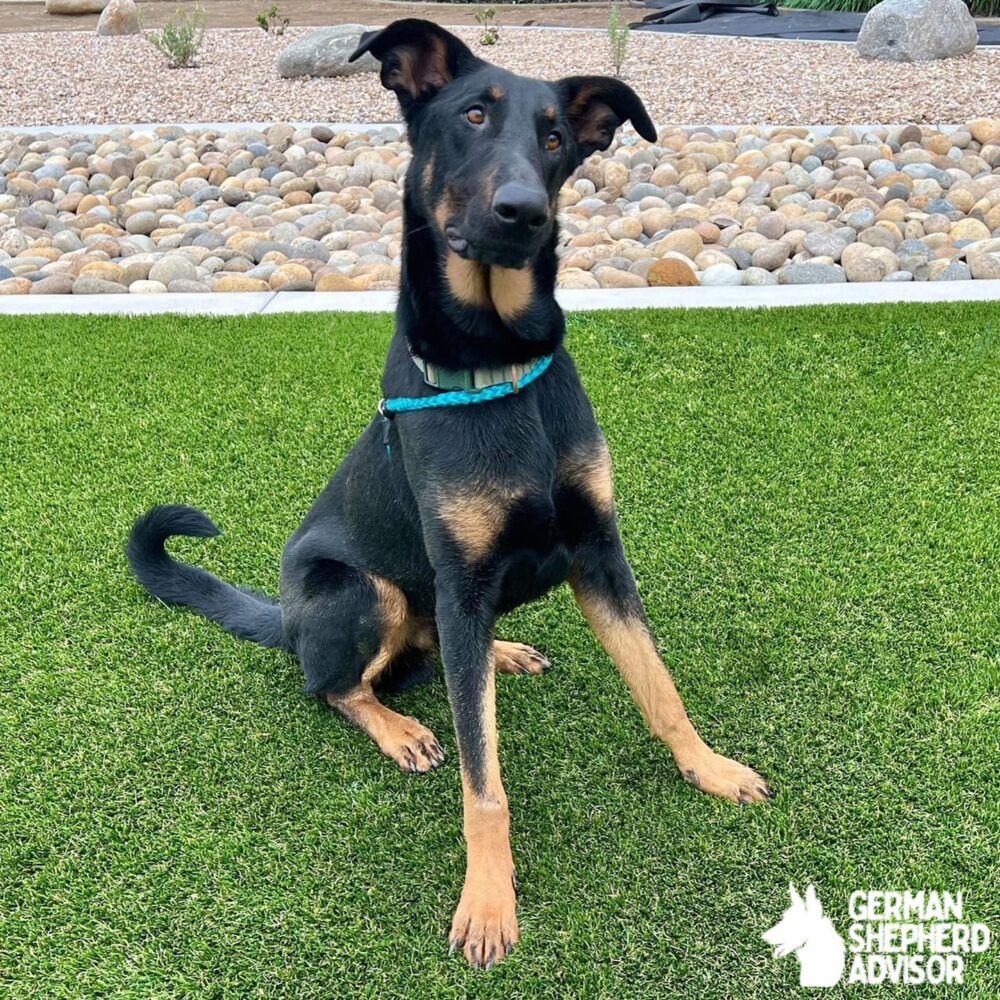
That puts them in the large dog breed category making it imperative that they have room to roam and adequate exercise to manage a healthy weight. A good diet and plenty of exercise will help to keep them at a healthy weight and avoid weight-related diseases.
The weight of a German Shepherd Doberman mix can vary based on genetics, diet, and lifestyle. Adopting a mixture of the 2 breeds will result in factors like genetics, weight loss plan and lifestyle on how heavy their measurement is. Overall, these dogs are big and brutish; they mirror the size of the parent breeds.
Here’s a breakdown of typical weight ranges for this mix:
Male Doberman Shepherd: Males typically weigh between 75-110 pounds (34-49 kg), although some may weigh slightly more, depending on their build and diet.
Female Doberman Shepherd: Females usually weigh a bit less, ranging from 65-90 pounds (29-41 kg).
How much does a German Shepherd Doberman mix puppy cost?
The average cost of a Doberman Shepherd (German Shepherd Doberman mix) in the USA depends on the location, breeder reputation, age and lineage. The average price for a German Shepherd Doberman mix puppy is between $200 and $500.
Getting a Doberman Shepherd from a rescue or shelter is an inexpensive choice, usually just the price of adopting their new best friend. Taking this route also means a good spot for an adopted dog. Local demand and supply may also vary the price. Breeding potential may make female puppies more expensive.
Is the German Shepherd Doberman mix right for you?
This breed thrives in active households where it can get plenty of physical and mental stimulation. They are best suited for experienced dog owners who understand the needs of intelligent, protective breeds.
Conclusion
When people hear the name of this hybrid breed, they tend to think German shepherd Doberman mix or Doberman Shepherd. In both cases, it represents a powerful, loyal, and intelligent combination. Given proper training, socialization and care, they can be wonderful companions for active individuals or families that have the time to give them a lot of effort. But, of course, to have a Doberman Shepherd live happily and healthily with them, prospective owners need to consider this exercise needs socialization in addition to known health issues related the breeds.
Frequently asked questions (FAQs)
Yes, with proper socialization and training, Doberman Shepherds can be excellent family dogs and are typically good with children. However, due to their size and energy, interactions with small children should be supervised.
Doberman Shepherds need at least 1-2 hours of exercise daily. They thrive with a mix of physical activities like running and hiking, along with mental stimulation through training and puzzles.
Due to their size and high energy levels, Doberman Shepherds are generally better suited to homes with outdoor space. However, they can adapt to apartment living if their exercise needs are met consistently.
With proper socialization, Doberman Shepherds can coexist with other pets. Early introduction and controlled interactions are recommended to avoid territorial or protective behavior.
Yes, they are intelligent and eager to please, making them highly trainable. Consistency, patience, and positive reinforcement are key to successful training with this breed.
References and sources:
- https://www.akc.org/dog-breeds/german-shepherd-dog/
- https://www.akc.org/dog-breeds/doberman-pinscher/
- https://www.petmd.com/dog/conditions/musculoskeletal/hip-dysplasia-dogs
- https://wagwalking.com/breed/doberman-shepherd
- https://www.alphapaw.com/dog-breeds/doberman-german-shepherd-mix/
- https://www.dogster.com/dog-breeds/german-shepherd-doberman-mix
- Images credit: sgvhumanesociety

